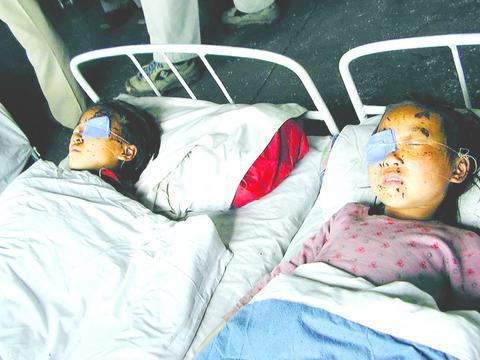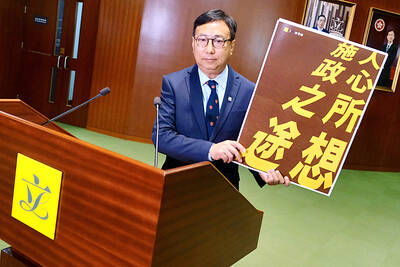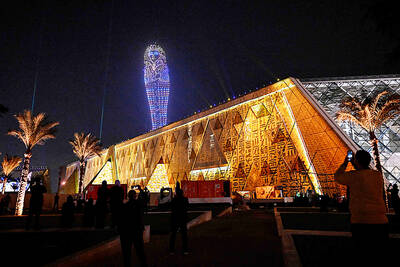Dozens of North Korean children who were badly burned or hit by debris during last week's train explosion are dying in pain because the ill-equipped hospital where they are being treated has been overwhelmed by casualties, it emerged on Sunday.
After the first visit by outsiders since the blast on Thursday, one international aid worker said the harrowing scenes inside the Sinuju hospital were among the worst he had seen in 20 years of humanitarian work.

PHOTO: AFP
The North Korean government said 161 people were killed in the disaster, which it blamed on human error. According to the state media, cargo wagons filled with oil and chemicals exploded when workers snagged the cars on power lines in a shunting yard.
Visitors to the Sinuju hospital were told the death toll is likely to rise because doctors lack medicines and the specialized equipment needed to treat burn patients.
Of the 360 people taken in for treatment, 15 have already died and 50 others are said to be in a critical condition. More than half of the victims are infants from a primary school that was devastated when the blast ripped through the town of Ryongchon.
"We saw about 40 of the wounded, most of whom were children with blast injuries," said Masood Hyder, the UN humanitarian coordinator in North Korea. "Basically, anyone who was looking in the direction of the explosion got [it] in the face."
Among the wounded were an 11-year-old boy, whose face had been ripped off, four children who had lost their sight and a comatose eight-year-old boy.
Even at the best of times, North Korea's dilapidated health system is unable to cope with normally treatable illnesses. After 10 years of famine, economic decline and government policies that devote all available resources to the military, most hospitals lack heating, running water, medicine, surgical tools and sterilizing equipment.
Aid workers said doctors in Sinuju hospital were over-run, the drips were antiquated and beds were in such short supply that injured children were having to lie on filing cabinets.
"It was one of the worst sights I have ever seen," said Richard Ragan, country director for the World Food Program. "You could hear the screams of children and it made you wonder whether there were any painkillers. The doctors are doing a heroic job, but they are overworked and under-resourced."
International aid is on its way. The World Food Program has provided food for the victims and the homeless; the Red Cross has distributed medicine, tents and blankets, and yesterday, the first convoy of about eight Chinese trucks drove across the border with instant noodles, bottles of mineral water and other relief supplies.
Japan, which has yet to establish diplomatic relations with Pyongyang, is said to have offered US$100,000 of emergency aid.
But visitors to the Sinuju hospital said specialized treatment would be needed to help the many people who have been blinded or badly burned.
"My sense is that they need supplies and technical expertise and they need it quickly," Ragan said.

‘CHILD PORNOGRAPHY’: The doll on Shein’s Web site measure about 80cm in height, and it was holding a teddy bear in a photo published by a daily newspaper France’s anti-fraud unit on Saturday said it had reported Asian e-commerce giant Shein (希音) for selling what it described as “sex dolls with a childlike appearance.” The French Directorate General for Competition, Consumer Affairs and Fraud Control (DGCCRF) said in a statement that the “description and categorization” of the items on Shein’s Web site “make it difficult to doubt the child pornography nature of the content.” Shortly after the statement, Shein announced that the dolls in question had been withdrawn from its platform and that it had launched an internal inquiry. On its Web site, Le Parisien daily published a

China’s Shenzhou-20 crewed spacecraft has delayed its return mission to Earth after the vessel was possibly hit by tiny bits of space debris, the country’s human spaceflight agency said yesterday, an unusual situation that could disrupt the operation of the country’s space station Tiangong. An impact analysis and risk assessment are underway, the China Manned Space Agency (CMSA) said in a statement, without providing a new schedule for the return mission, which was originally set to land in northern China yesterday. The delay highlights the danger to space travel posed by increasing amounts of debris, such as discarded launch vehicles or vessel

RUBBER STAMP? The latest legislative session was the most productive in the number of bills passed, but critics attributed it to a lack of dissenting voices On their last day at work, Hong Kong’s lawmakers — the first batch chosen under Beijing’s mantra of “patriots administering Hong Kong” — posed for group pictures, celebrating a job well done after four years of opposition-free politics. However, despite their smiles, about one-third of the Legislative Council will not seek another term in next month’s election, with the self-described non-establishment figure Tik Chi-yuen (狄志遠) being among those bowing out. “It used to be that [the legislature] had the benefit of free expression... Now it is more uniform. There are multiple voices, but they are not diverse enough,” Tik said, comparing it

Prime ministers, presidents and royalty on Saturday descended on Cairo to attend the spectacle-laden inauguration of a sprawling new museum built near the pyramids to house one of the world’s richest collections of antiquities. The inauguration of the Grand Egyptian Museum, or GEM, marks the end of a two-decade construction effort hampered by the Arab Spring uprisings, the COVID-19 pandemic and wars in neighboring countries. “We’ve all dreamed of this project and whether it would really come true,” Egyptian Prime Minister Mostafa Madbouly told a news conference, calling the museum a “gift from Egypt to the whole world from a